How Assassin’s Creed Mirage Took the Franchise Back to Its Roots and Recreated a “Lost City”
To celebrate 16 years of the blockbuster video game franchise, the talented developers at Ubisoft Bordeaux transport players to 9th-century Baghdad for Assassin’s Creed Mirage.
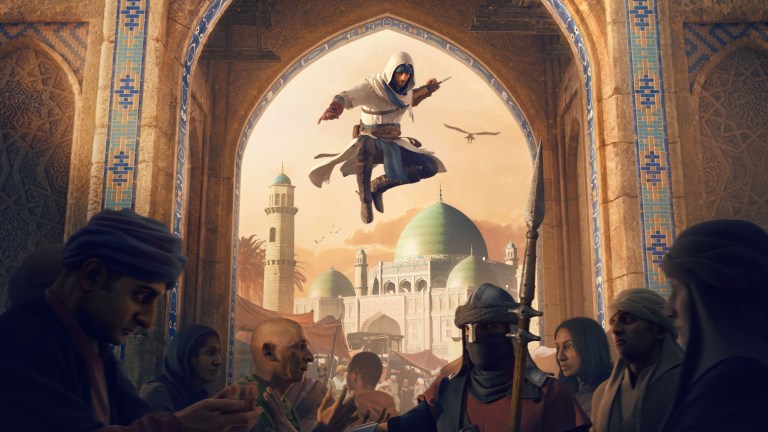
This article appears in the new issue of DEN OF GEEK magazine. Get your copy here.
When the original Assassin’s Creed first hit store shelves in 2007, it was unlike anything else you could play on consoles that holiday season. Sixteen years later, we take that game’s winning combination of stealth gameplay, melee combat, parkour traversal, and open-world historical setting—all somehow also wrapped up in a compelling sci-fi thriller—for granted. But that’s because so much of the open-world formula the original title helped pioneer has become the standard language of modern gaming.
It’s why, in recent years, Assassin’s Creed publisher Ubisoft worked to freshen things up with a trilogy of games that emphasized loot-driven RPG mechanics over the original’s more linear, stealth-focused approach. But while those three installments—Origins, Odyssey, and most recently, Valhalla—were undeniable success stories for the franchise, Ubisoft is now going back to basics to celebrate the 16th anniversary of the long-running series.
This month’s Assassin’s Creed Mirage not only returns to a Middle Eastern setting but brings back many of the design elements that made the original game so great. All while following up on plot threads from Valhalla and adding a few new wrinkles to the series’ sprawling story. But that last part is easier said than done. In fact, when Den of Geek magazine sits down on a video call with the team at Ubisoft Bordeaux, Mirage narrative director Sarah Beaulieu doesn’t mince words about the biggest challenge to telling a new story in this universe: “When you actually approach this kind of lore, it’s 16 years of Assassin’s Creed, so it’s huge. Let’s put a word on it: it’s a mess. You have to choose what you can do and what you can’t do. You don’t want to make any mistakes with the lore because we have a responsibility.”
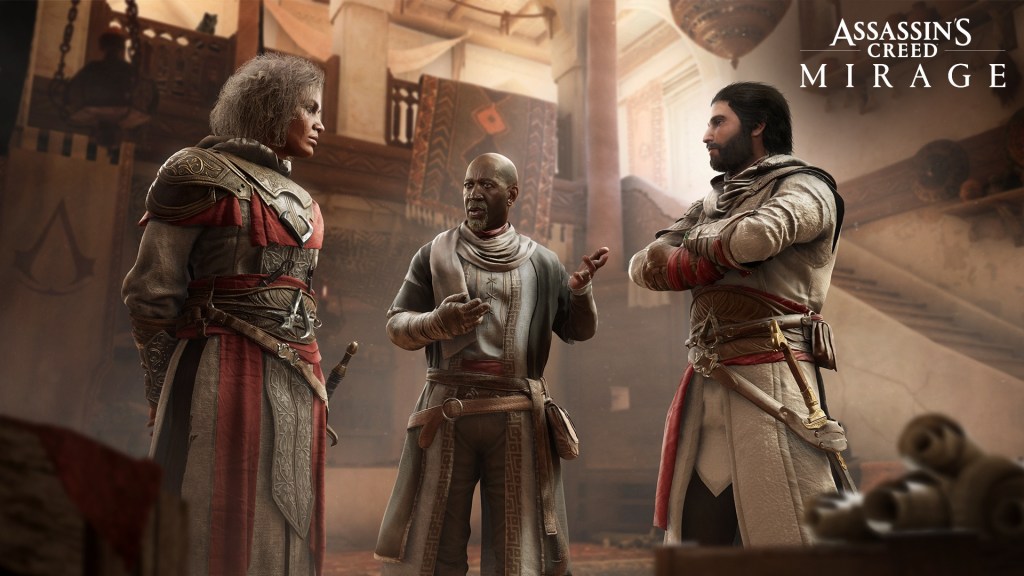
The Assassin
The word “epic” doesn’t begin to cover this time-hopping saga. The Assassin’s Creed story spans millennia of real (and alternate) historical events, multiple protagonists, and even different realities. It also involves the Isu, a prehistoric advanced species that ruled over Earth like gods before a Great Catastrophe wiped them all out. The games largely follow the Assassins (or Hidden Ones) as they try to recover powerful Isu relics before the power-hungry Templars can use them for world domination. Meanwhile, Assassins in the present day are also fighting to prevent a second Great Catastrophe that will wipe out our civilization. Yes, there’s a lot going on.
Fortunately, the team knew exactly where to go next with the story and who to go there with: Basim Ibn Ishaq, a troubled Assassin who was first introduced in Valhalla, which is set in the 870s during the Viking expansion into Britain. In that game, a third-act twist reveals Basim is actually the villainous reincarnation of a manipulative Isu named Loki. But Mirage takes place almost 20 years earlier in 9th-century Baghdad—before Basim becomes a Hidden One or learns that he’s actually a reborn Isu.
“When we started working on Mirage, we were looking for a character that we could really tell the coming of age story with,” says creative director Stéphane Boudon. “There’s so much to tell and so much to untie [with Basim].”
Basim was not only a great choice because of the mystery surrounding his past, but he also lived during the time period the studio wanted to explore—the Golden Age of Baghdad, when the city was the center of culture, science, and invention. As Beaulieu says, “All the stars aligned.”
But were they ever worried players wouldn’t sympathize with the coming-of-age story of an Assassin we all know will one day become a major villain?
“We didn’t see him as the bad guy [in Valhalla]. We saw him as a guy with a lot of flaws and a huge blank page that we wanted to fill,” Beaulieu says. “So the first thing we wanted to do is just think about what happened; why did he become the guy you met in Valhalla?”
At the start of Mirage, Basim is surviving as a street thief before he is recruited by the Brotherhood. It’s a somewhat common origin story for Assassin’s Creed, but remember, Basim isn’t your ordinary Assassin. “He’s tortured by visions, and he has this trauma that he can’t deal with because he doesn’t know where it comes from,” Beaulieu explains. “He has something to resolve first before becoming a Hidden One.”
Finding the hero of the story was only one piece of the much larger puzzle, though. Ubisoft Bordeaux would also need to build a city from scratch, a completely different kind of undertaking.
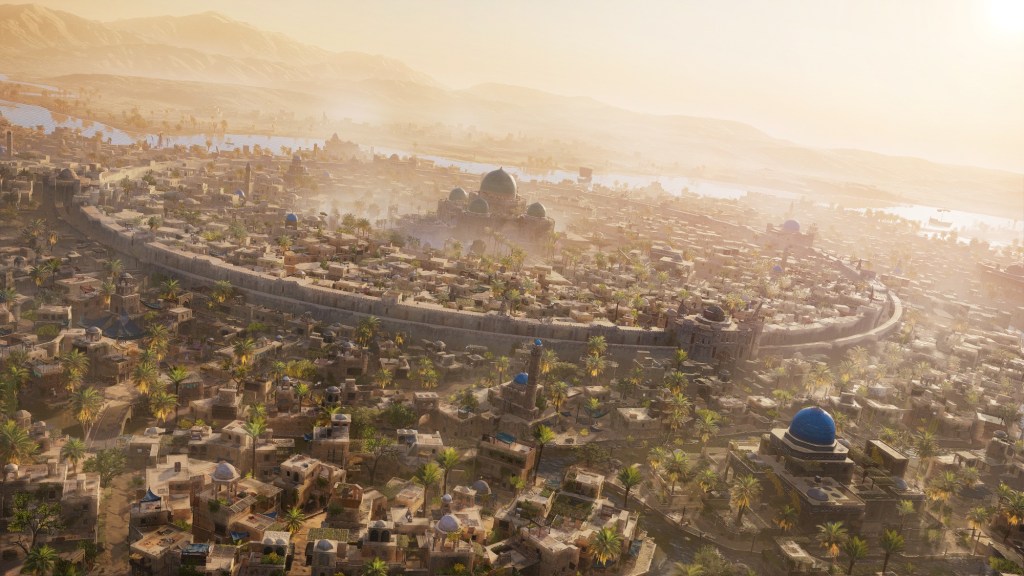
The Lost City
“The Middle East was a must-have for us from the get-go,” Boudon says. “When we were doing our research on the Middle East, Baghdad was so powerful, like a lighthouse in the dark, it was obvious for us.”
Mirage features an approximation of what 9th-century Baghdad might have been like during the Anarchy of Samarra, a time of great upheaval in the city and the whole of the Abbasid Caliphate, the Islamic empire that ruled much of the region at the time. Through years of research and consultations with historians, Ubisoft Bordeaux sought to craft as authentic a depiction of the city as possible. But that was easier said than done, especially as they learned how much of the real 9th-century city had been lost to time.
“The city itself, there’s nothing remaining now,” Beaulieu laments. “We don’t have anything, not one single stone from the 9th century. It’s not the same thing as in Greece or Rome.”
This was the biggest obstacle for Mirage art director Jean-Luc Sala, whose job it was to visualize the four districts of the game version of Baghdad—the wealthy Round City, the cultural hub of Abbasiyah, the industrial Harbiyah, and the markets of Karkh—despite being unable to visit any historical sites from the time period for reference.
“Medieval Baghdad is a ‘lost city’ which was destroyed by the Mongols during their conquest of the Middle East. Bringing it to life with the few existing historical sources was a fantastic challenge for the team,” says Sala, who used the writings and maps of 19th-century British scholar Guy Le Strange as the foundation for his designs. Le Strange himself referenced the works of Arabic and Persian medieval sources, such as historians Serapion the Elder and al-Yaʿqūbī “to create a map that is still the reference today,” according to Sala.
The mission wasn’t just to recreate the aesthetic and geography of the ancient city. According to the team’s historian, Raphaël Weyland, the task also involved digging into what life was really like in Baghdad at that time.
“Recreating a city for an AC game is an immense challenge,” Weyland says. “It requires a deep understanding of multiple aspects of the life of that city, many of which historians don’t always think of—political events and life of the court, of course, but also the general layering of the city and how it affected transportation; what elite as well as less fortunate people looked and sounded like; what people ate, how they relaxed, what they considered beautiful or ugly.”
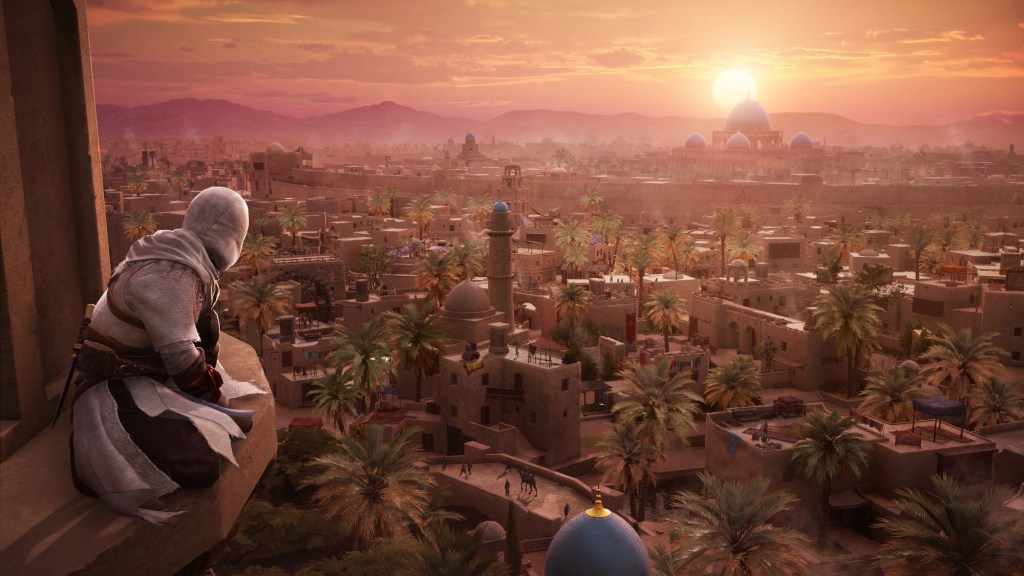
Weyland turned to many sources to study the culture: “For music and the life of famous singers we used the Kitab al-aghani (Book of Songs) by Abu al-Faraj, while for table manners used the Kitab al-bukhala (Book of Misers) by Al-Jahiz.” Ubisoft also collaborated with museums, which provided artifacts from the era. The team studied “everything from uniforms and weapons to floor tiles and astronomical instruments” for inspiration. “Finally, some aspects are directly inspired by modern Iraqi craftspeople who still build boats and tools that look almost identical to the ones Basim would have seen 1200 years ago,” Weyland says.
But for every historical source and relic studied, there were locations in 9th-century Baghdad for which virtually no archaeological evidence exists today. Case in point: the House of Wisdom, which was one of the largest libraries in the world until the Mongols destroyed it in 1258. “We didn’t really know where it was exactly or even the shape of it,” Boudon says. “[We] took inspiration from other cities and writings.” Players can visit the House of Wisdom in the Abbasiyah district, a location tied to Basim’s own childhood.
Sala also turned to his own memories of growing up “on the other side of the Tigris River” to capture what he calls the “Spirit of Baghdad.” For Sala and many others on the team, recreating this lost city was about more than just providing a playground for Assassin’s Creed fans to parkour around. It was about highlighting a time period that is so often overlooked in history books, classrooms, and even pop culture.
“We wanted to do justice to the Abbasid period because in movies and popular culture, it is a rare subject and most of the time given the ‘Arabian nights cliché’ treatment,” Sala explains. “It was the most advanced place in the world during the Abbasid Golden Age. At the same time, Europe was living in its ‘Dark Ages.’ So, showing this amazing world at the peak of its glory felt important for us.”
Years of crafting the game’s story, which includes the many real historical figures Basim meets along his quest, have also led Beaulieu to ask an uncomfortable question about which parts of history get to live on and which are left by the wayside.
“You learn about Rome, you learn about Greece, but not 9th-century Baghdad. Why?” Beaulieu says. “The more we [researched], the more we discovered different characters like the Banū Mūsā brothers who were inventors, and they were very famous back in the day and invented all this stuff…That’s a bit like Da Vinci. Everyone knows about Da Vinci, but most people don’t know about the Banū Mūsā.”
Past Assassin’s Creed games have featured plenty of famous historical figures, from Da Vinci and Socrates to George Washington and Cleopatra. Mirage is an opportunity to put the movers and shakers of the Golden Age of Baghdad on the same pedestal. Basim does indeed work with the Banū Mūsā in Mirage, but Ubisoft Bordeaux’s efforts to bring authenticity to their version of 9th-century Baghdad go beyond the game’s plot. Mirage not only lets you play the entire game in Arabic, it accurately depicts the Adhan, the Islamic call to prayer. Mirage also features an in-game Codex with a “History of Baghdad” section that provides context for the different places Basim visits, the historical figures he meets, and items he finds. The database includes articles as well as art and photographs curated by museums around the world. The hope is that this will be a valuable resource for both history lovers and those who haven’t encountered 9th-century Baghdad in the classroom before.
“Assassin’s Creed games are not meant to replace teachers or university classes, but they can serve as a great entry point into a culture,” Weyland says. “If in five years someone chooses a class about medieval Middle Eastern history because of Assassin’s Creed Mirage, it would be wonderful!”
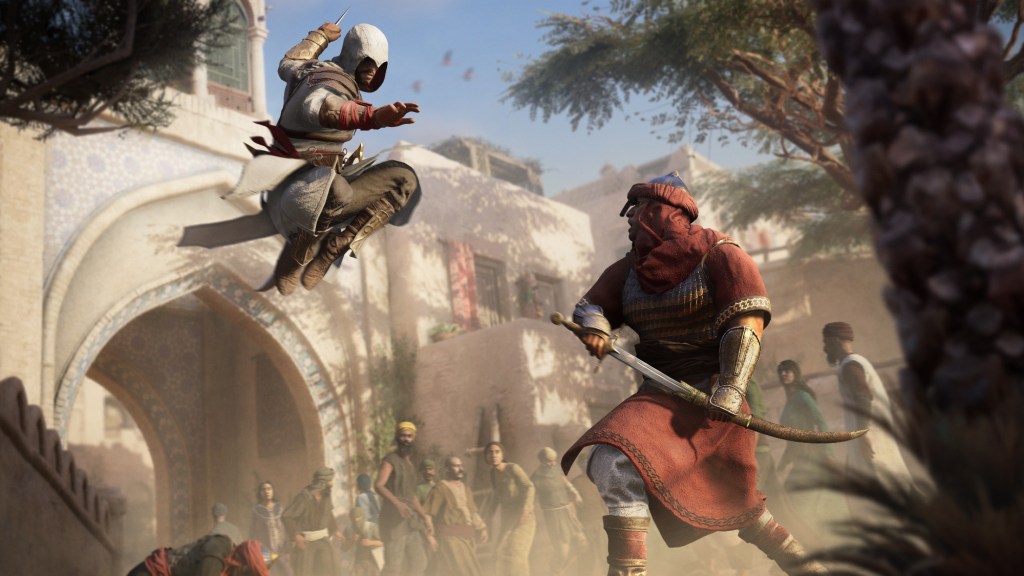
16 Years Later
Mirage doesn’t just look back at real-world history; it also dissects the franchise’s own past. From the beginning, Ubisoft Bordeaux’s goal was “to go back to the roots of the franchise,” according to Boudon. That’s why Mirage is a more linear experience set in an urban landscape like the earliest games and emphasizes stealth, parkour, and a more nuanced approach to assassinations. But that wasn’t as simple as doing whatever the first game did.
“We didn’t want to just copy past eras,” Boudon explains. “We had creative liberty to change things. For instance, stealth was a big part of the rework. We crafted a new stealth loop [and] we also give you tools that let you play a bit with the AI. We reworked AI detection as well. That’s why we brought back the vision cone for AI and the ‘Last Known Position.’”
Last Known Position, a visual marker that pinpoints where enemies last spotted the player during tense chase sequences, goes hand in hand with the welcome return of the Notoriety system, which makes enemies more aggressive towards the player as they commit more crimes. The higher Basim’s Notoriety, the faster city guards will attack him, making taking down targets more difficult. Of course, Basim has plenty of tools he can use to evade enemies, including smoke bombs, noisemakers, blowdarts, and even poison traps for a more lethal solution.
Assassinations have received a bit of an overhaul as well. Mirage asks players to do some investigating to track down targets, which may mean snooping on conversations, pickpocketing, or bribing someone for intel. Mirage also encourages players to explore different ways to get the kill, whether it’s sneaking, sabotage, or a more direct approach. A new ability called Assassin Focus also allows Basim to slow down time and take down several enemies at once, a nifty trick when you’re in an area full of guards.
As for the all-important parkour element, Mirage brings a more fluid traversal experience, with plenty of ways to move around the city without breaking the momentum. According to Sala, “the flat rooftops and the intricate and chaotic urbanism of the Abbasid architecture also helped a lot to bring back the parkour comfort and the nostalgia of the first AC game.”
Nostalgia was a key consideration, of course. That’s why the team included plenty of easter eggs and blasts from the past, such as the Assassin fortress of Alamut, which players can visit to learn more about the Brotherhood. But it wasn’t all about fan service. This game is the culmination of a long, emotional journey, both for the studio as a whole and the individual creators we spoke to for this piece.
Mirage marks Ubisoft Bordeaux’s first release as the lead studio of a project this size, having previously worked in more of a supporting role, including on Ubisoft Montreal’s Valhalla, since its founding in 2017. Sala describes it as a “growing up” of the team. Meanwhile, Beaulieu feels a mix of emotions as they reach the finish line. She points out that “everybody [on the team] put something very intimate at some point somewhere” in this game.
For Boudon, the fact that they’ve hit this milestone with an Assassin’s Creed game makes it all that much sweeter. Although he was working with a completely different Ubisoft studio in France in 2007, Boudon loved the original Assassin’s Creed game so much that he tried to get himself transferred to the AC team in Montreal. It didn’t work out back then, but 16 years later, things have come full circle for him.
“Now I can work on an Assassin’s Creed and make a tribute to that original game. It’s an honor for me to be a part of that storyline,” Boudon says. “It’s incredible.”
Assassin’s Creed: Mirage is out now on Xbox and PlayStation consoles as well as PC and Amazon Luna. An iOS version of the game is slated for 2024.
